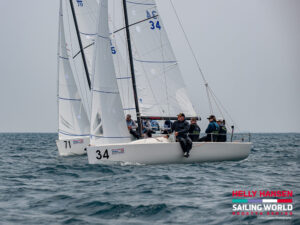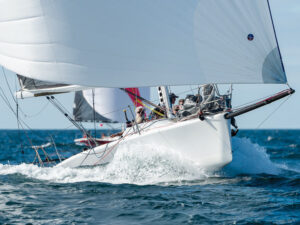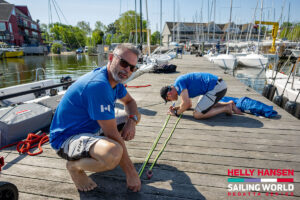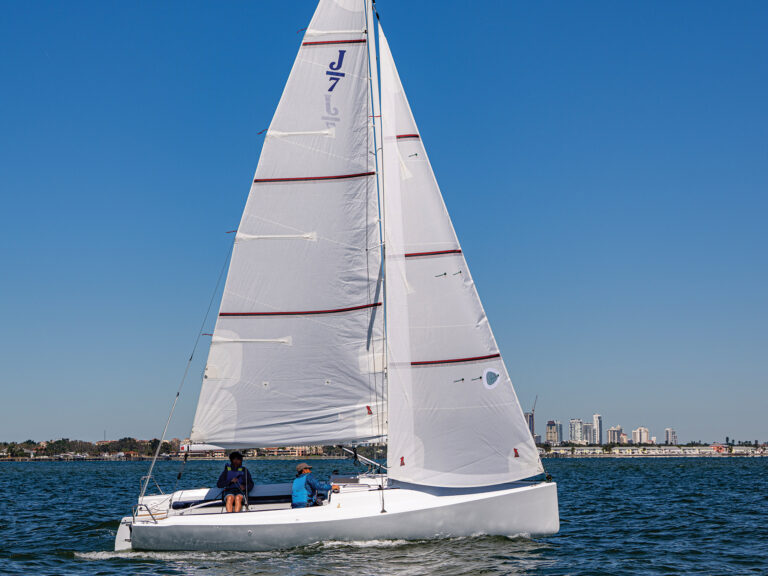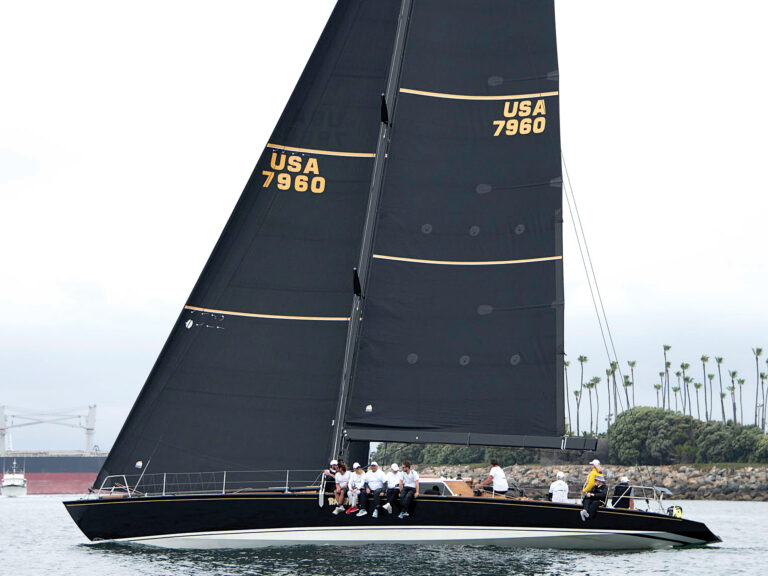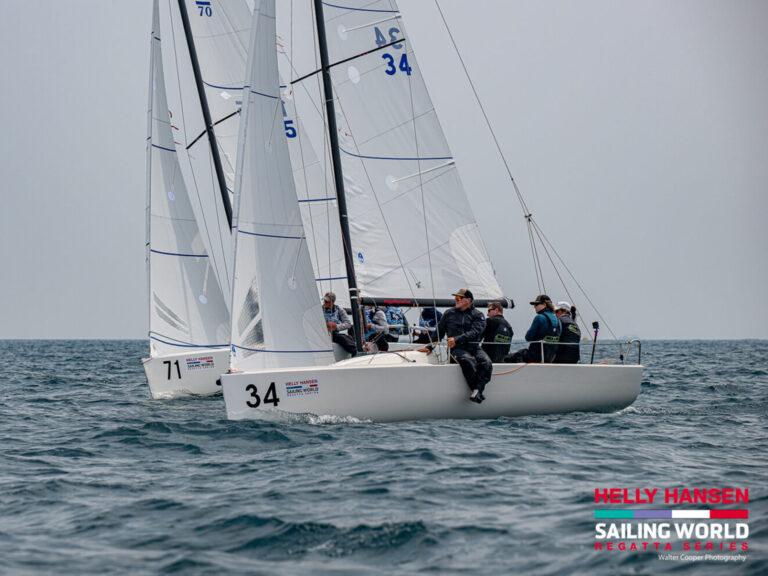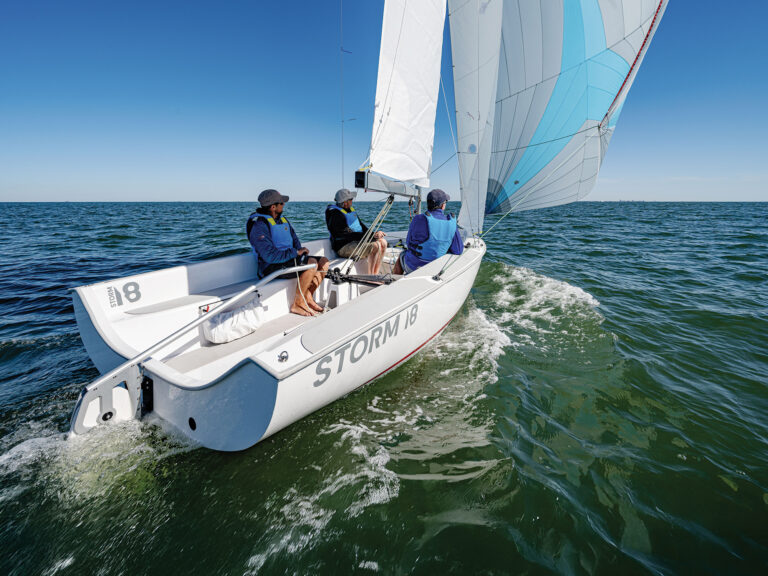
Star Crossing
Our dinghy-sailing doc finds his old pal Racer Rob one morning at the boat park and is called into session once again.
Doc: Rob, why are you here so early?
Rob: Have a look at this Doc. I should have gone right through the guy. Billy pulled a fast one on me at the top mark.
Doc: That’s a nasty chip in the gel coat.
Rob: I was on port tack, coming into the top mark, and Billy was on starboard. I pulled away to dip his stern and his mainsheet let go. He stopped dead in the water. I nearly missed him though. I yelled at him to do a 720, but he said I was in the wrong. When I spoke to my coach, she asked about something called “eight crosses,” and then sent me to you muttering something about a “head case.” Do you have any idea what she is talking about?
Doc: Ah yes, the eight crosses. I’m guessing you’ve never heard of them.
Rob: Are you trying to make me feel silly, or do you just do that naturally?
Doc: Apologies. Yes, the eight crosses. What she is talking about are the standard moves for a port-starboard crossing situation going upwind. There are five standard port-tack moves, and three starboard-tack moves.
Rob: You’re kidding me, right?
Doc: Well, yes, actually I am. There are a lot more than that if the port-tack boat intends to tack. The eight crosses are literally that-different ways to manage a cross when the port-tack boat intends to dip.
Rob: Go on then. This stuff is always entertaining, and I’m up for a laugh.
Doc: All right. Here is the list. On port, there is the standard dip, the late dip, the high dip, the stop dip, and the disaster dip.
Rob: I like the sound of that last one.
Doc: And on starboard there is the full-speed cross, the hunting cross, and the speed-controlled cross.
Rob: How do they all work?
Doc: The first and most important message is that some of these do not work as well on keelboats. You will understand better when you know what each does. These techniques work best on boats that accelerate quickly, move a lot faster in footing mode than pointing mode, and don’t lean over. That is, some of these tricks work really well in high-speed dinghies, but should be used with caution in slow, heavy keelboats.
Rob: Tell me how these work.
Doc: Let’s start with the port-tack situations. The standard dip is the one you read about in all the textbooks. You make the decision to dip early, you accelerate the boat into the dip, and you make sure you are moving at full speed and are hard on the wind as you cross the stern of the starboard boat.
Rob: Yep. Know about that one.
Doc: The second is the late dip. This is used when you are concerned the starboard-tack boat might try and tack on top of you. So you crowd his space. You hold your course until very late and then do a sharp bear off very close to the starboard boat. The starboard boat will have to tack carefully or he will push his stern into you. Although a late dip will cost some ground compared to the standard dip, you end up with a maximum gap between yourself and the recently tacked starboard boat, which has also probably done a bad tack, and later, perhaps, than he wanted to.
Rob: That’s pretty cool. I can see what you mean about the keelboats though. Try that in 15 knots in an Etchells.
Doc: Exactly. The next dip is the high dip. This is the dip you use when you need to maintain your port-tack lane. It’s particularly effective if you are on port tack and you have another boat on port a couple of lengths to leeward and ahead. If you do a standard dip, then you’ll probably end up in the port-tack boat’s bad air, so instead of accelerating the boat, you go into a high and slow mode and allow the starboard-tack boat to cross without dipping much, if at all. You may lose a bit of distance, but you’ll maintain your lane.
Rob: So that’s what you mean when you say you need a difference between pointing and footing mode. That would work very well on a skiff, but for a keelboat it’s much more challenging.
Doc: That’s right. Although a variation on the high dip, the stop dip, can still work OK for keelboats. Stop dips are expensive. The only time I’ve seen one work well was on a keelboat where we were sailing along the port-tack layline toward a starboard rounding. A starboard-tack boat came through late, and if we had dipped we would not have fetched the mark. Instead, we dumped both main and jib, allowed the starboard-tack boat through, and were still able to sheet on and re-accelerate before the starboard boat had completed its tack.
Which brings me to the disaster dip. It’s called a disaster dip for obvious reasons-something has gone seriously wrong. This is the technique to use when you thought you could get across in front of the starboard boat, but ended up a few feet short. The worst outcome here is serious damage. The next worst outcome is a 720. If you are caught in this situation, your best chance is not to go into denial and hope it will all go away. Dump the main and bear away hard. Your stern will spin away from the bow of the starboard-tack boat, and, hopefully, will prevent both a collision and a penalty.
Rob: Not pretty.
Doc: So let’s talk about the starboard tackers. The first is the full-speed cross. I’m constantly surprised at how few people follow the basic crossing strategy, which is to do all standard crosses at high speed. When in a standard crossing situation, always go into footing mode. If the port-tack boat tacks under your bow, you can come back on the wind and at maximum speed, and they will have been forced to tack earlier than they would have liked. If they intend to tack onto your air, then you have your best speed to break through to leeward or to immediately attack with a simultaneous high-speed tack.
Rob: But wouldn’t it be smarter to go into high mode and stop them getting across your bow? I mean, going low and fast will make it easier for them to cross you.
Doc: You are right. But when you do that, you will almost certainly be forced to tack. They will be close under your bow, and you’ll be going slow and have no space to accelerate. What you have described, in fact, is a mild form of the hunting cross. You use this cross when you are trying to force the port-tack boat to head left (presumably, so you can tack and head right).
Rob: I thought the rules prevented “hunting” in fleet racing.
Doc: It is a tricky one, and variations on the water are certainly subtle. It’s important to understand this cross though, for two reasons. Firstly, it may be used against you, legally or illegally, and therefore you need to watch for it. The second reason is that the maneuver may not be illegal, depending on the circumstances. The rule you’re referring to is 16.2, which limits course changes by a starboard-tack boat when a port-tack boat is keeping clear by sailing to pass astern of the starboard-tack boat. There is certainly plenty to debate on this one.
Rob: Fair enough. It sounds a bit dodgy to me.
Doc: It would certainly be a safe bet to have a high ratio of number of protests to the number of times attempted.
Rob: What about this last one, the speed-controlled cross.
Doc: That’s the one you just got done on!
Rob: What do you mean?
Doc: Rule 16 talks only about “course” and not “speed.” When Billy dumped his mainsheet, he did not break any rule. You were still required to keep clear of him. Now, do you think you might be able to use that tactically?
Rob: That’s the answer I needed at the Nationals. I was five boatlengths below the port-tack layline for the boat end of the finish line. The reason I was nearly on the layline was that the wind had swung hard left on the last beat, and the line was so heavily biased to the boat end that it was nearly impossible to cross on starboard tack. I had another boat on my weather hip barely laying the finish boat. But I had starboard rights. I tacked to starboard on the layline. The problem was he had just enough room to dip me and luff across the finish line. A speed-controlled cross would have forced him below the finish line.
Doc: And a hunting cross might have forced him to tack onto your lee bow.
Rob: And that is supposed to make me feel better?
Doc: Yes, well, I guess that is my job.
Rob: Well, try a little harder would you.

